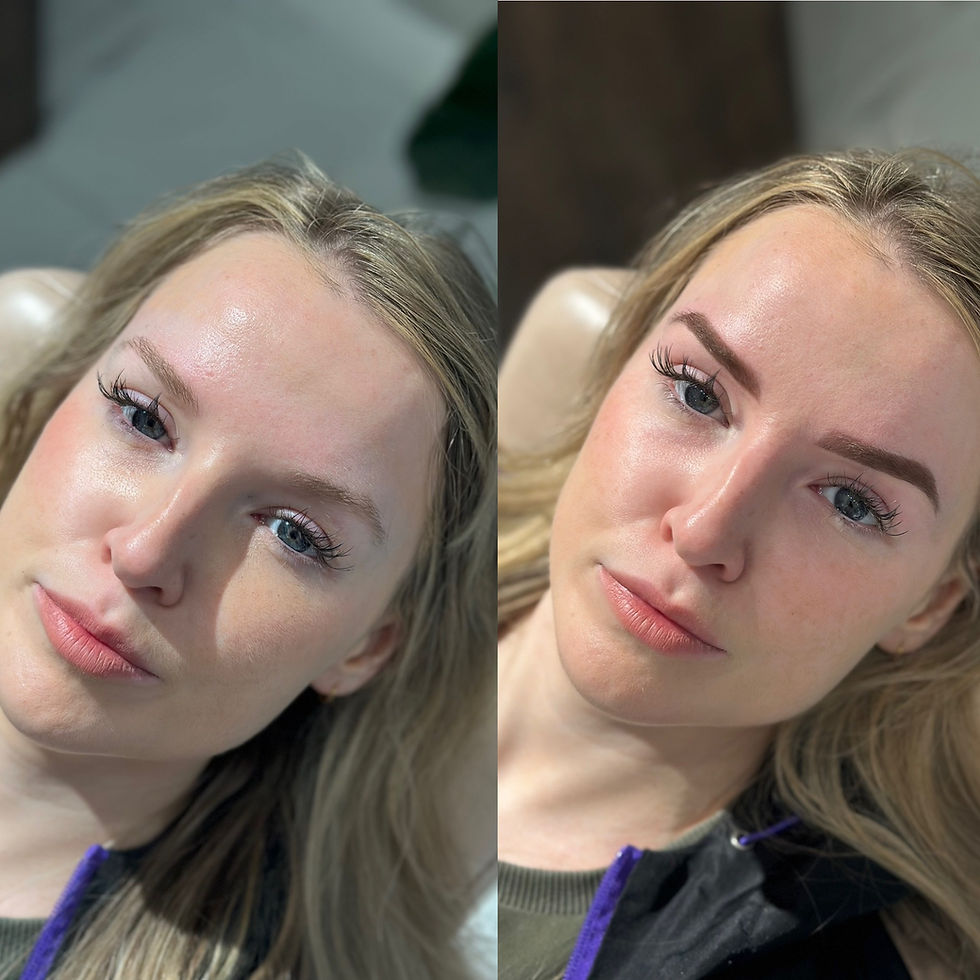The Pigment Paradox: Why Real Artists Work in Fades, Not Permanence
- Ira Bale

- 2 days ago
- 3 min read
By Ira Bale – Cosmetic Tattoo Artist, Melbourne, South Yarra & Toorak Village
Because beauty that stays forever shouldn’t look like it.
1. The Biggest Lie in Cosmetic Tattooing
There’s a phrase that makes me wince every time I hear it:“Permanent makeup.”
The truth? Nothing in skin is permanent, and that’s a good thing.Because permanence in pigment isn’t mastery. It’s malpractice.
At Ira Bale Brows, I tell every client in South Yarra and Toorak Village the same thing:
“The best work fades, beautifully, predictably, and intelligently.”
That’s not a sales line. It’s biology.

2. Skin Is a Living Organ, Not a Canvas
The skin is alive — elastic, self-renewing, constantly metabolising. Every 28–40 days, the epidermis replaces itself. The dermis, where pigment lives, thins with age, UV exposure, and hormone shifts.
So when an artist injects pigment that doesn’t fade, it’s not “lasting power.” It’s over-saturation.That pigment is sitting too deep, too dense, and too dark. Eventually, it migrates.
And that’s when brows turn blue, lips turn grey, and the word “permanent” becomes regret.
3. The Chemistry Behind Controlled Fading
Every pigment is built from molecules — iron oxides, titanium dioxide, or organic dyes. Each has a different molecular weight and lightfastness, meaning how it reacts to UV radiation and oxygen exposure.
At Ira Bale Brows, we work exclusively with fade-engineered pigments, those calibrated to break down gradually under the skin’s natural exfoliation cycle.
This ensures that what disappears first is not your shape, but your saturation. Your design remains intact; your tone gently softens.
It’s like time-lapse art, designed to age gracefully.
4. Why “Long-Lasting” Isn’t Always “Good”
Cheap pigments are dense, opaque, and stubborn. They resist fading not because they’re superior, but because they’re contaminated with heavy metals or synthetic stabilisers.
They don’t respect biology, they fight it.
And when that happens, the skin’s immune system treats pigment like an invader. Macrophage cells — the skin’s clean-up crew, surround the particles and hold them hostage. That’s why you can still see pigment decades later: it’s not colour, it’s inflammation containment.
That’s not art. That’s injury.
5. The Psychology of Fading
Clients often ask, “Will it last forever?” My answer is always, “No, and thank goodness.”
The psychology of fading is about control.When something evolves gently, it lets you evolve with it.Your face changes with age, hormones, and emotion. Your brows and lips should be allowed to adapt too.
Fading isn’t failure. It’s freedom.
6. Artists Who Fear Fading Don’t Understand Design
Bad artists overcompensate with density. They fear what they can’t control, pigment loss, undertone shifts, or client dissatisfaction. So they go darker, deeper, heavier.
But a real artist plans for fading.We design in layers.
At my South Yarra salon, I always say:
“If it looks perfect when you leave, it’s probably too dark. If it looks slightly too soft, it’s probably just right.”
That’s the science of restraint, knowing when to stop.
7. The Ethics of Impermanence
There’s an ethical dimension here that the industry doesn’t talk about enough.When we work in skin, we owe it respect, it’s not ours to dominate.
An artist’s job isn’t to leave a mark forever. It’s to create something that belongs to you now, and fades with dignity later.
That’s the quiet beauty of impermanence, it honours the body’s autonomy.
8. The Colour Correction Myth
Most correction cases I see in Toorak Village aren’t because the artist chose the wrong colour. It’s because they chose the wrong permanence.
You can neutralise undertones all you want, but if the pigment is embedded too deep, no colour theory can save it.
That’s why I teach my team: Fading isn’t a flaw to fix. It’s a design feature to control.
9. What Real Longevity Looks Like
Real longevity isn’t how long pigment stays. It’s how long it looks good while it’s there.
The brows that still look elegant three years later are the ones that faded gradually, never harshly.The lips that age beautifully are the ones tattooed with restraint, not saturation.
In the same way a luxury garment wears in, not out, true tattoo heals into harmony, not hardness.
10. The Future Is Designed Fading
The new standard in cosmetic tattooing isn’t “forever.” It’s fade engineering — designing the life cycle of pigment from implantation to release.
It’s science, not guesswork. It’s ethics, not ego.And it’s where the industry should have been years ago.
Because real artists don’t fear fading, they choreograph it.And in the end, the most beautiful work isn’t what lasts forever, it’s what stays beautiful while it does.
Discover the difference between fading and failure at Ira Bale Brows South Yarra and Toorak Village, where impermanence is the art form, not the accident.



Comments